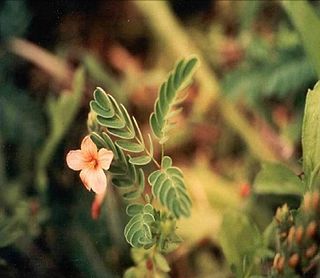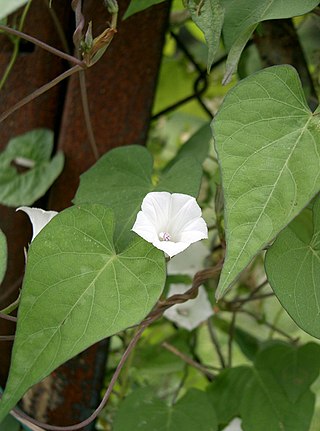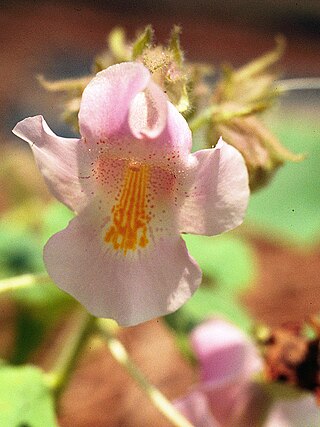
Phacelia crenulata is a species of flowering plant in the borage family, Boraginaceae. Its common names include notch-leaf scorpion-weed, notch-leaved phacelia, cleftleaf wildheliotrope, and heliotrope phacelia. Phacelia crenulata has an antitropical distribution, a type of disjunct distribution where a species exists at comparable latitudes on opposite sides of the equator, but not at the tropics. In North America, it is native to the southwestern United States as far east as Colorado and New Mexico, and Baja California and Sonora in Mexico. In South America, it is native to southern Peru, western Bolivia, and northern Chile.

Caragana halodendron is a species of flowering plant in the pea family (Fabaceae). It is known by several common names, including common salt tree and Russian salt tree. It is native to Russia and southern Asia, but it can be found on other continents where it is an introduced species, and one that is often a noxious weed. This is a deciduous spiny shrub sprawling to a few meters in maximum width and up to three meters tall. Stems branch from the base and bear clusters of about four leaflets on sharp spurs. The ends of branches narrow to spines. Flowers also appear at the ends of spurs in clusters of two to four pink pealike blossoms each one to two centimeters wide. The fruit is a black woody inflated pod about 2 centimeters long containing legume seeds. The plant has a deep and wide root system, with the lateral roots sending up new shoots. In this manner the plant forms extensive thickets. When introduced to an area of suitable climate, such as California where it is a known weed, it can invade cultivated land and spread relatively quickly. It is tolerant of saline soils.

Crupina vulgaris is a species of flowering plant in the family Asteraceae. Its common names include common crupina, bearded-creeper, false saw-wort, and starry scabious. It is native to parts of Europe, Asia, and North Africa, and it is known elsewhere as an introduced species and often a noxious weed.

Diplotaxis tenuifolia is a species of flowering plant in the mustard family known by the common name perennial wall-rocket. It is native to Europe and western Asia, where it grows on disturbed ground and roadsides, and it can now be found throughout much of the temperate world where it has naturalized. In recent years it has increasingly been cultivated to produce salad leaves, which are marketed as wild rocket in Britain or arugula in the US. It is easily confused with garden rocket, which has similar uses.

Aubrieta deltoidea is a species of flowering plant in the mustard family. Common names include lilacbush, purple rock cress and rainbow rock cress. It should be grown in zones 4a to 9b.

Alyssum alyssoides is a species of flowering plant in the mustard family known by several common names, including pale madwort and yellow alyssum. It is native to Eurasia, but it can be found throughout much of the temperate world as an introduced species and sometimes a common weed. For example, it has been noted as a weed in the western United States. It often appears in arable fields, sandy tracks, pits, and docks.

Anoda cristata is a species of flowering plant in the mallow family known by many common names, including spurred anoda, crested anoda, and violettas. It is native to North and South America. It is known throughout the rest of the Americas as well as Australia as an introduced species and often a noxious weed. It has been found as a weed in Belgium. Naturally, it is often found near streams, in moist meadows, and in disturbed areas.

Astragalus inyoensis is a species of milkvetch known by the common name Inyo milkvetch.

Cytisus multiflorus is a species of legume known by the common names white broom, white spanishbroom and Portuguese broom.
Lessingia arachnoidea is a rare species of flowering plant in the family Asteraceae known by the common name Crystal Springs lessingia. It is endemic to California, where it is known from a few occurrences in the vicinity of Crystal Springs Reservoir on the San Francisco Peninsula and southward to serpentine soil in Woodside. It may also exist in Sonoma County to the north. The plant grows in chaparral, scrub, grasslands and other local plant communities, on serpentine soils.

Rapistrum rugosum is a species of flowering plant in the mustard family known by the common names annual bastardcabbage, common giant mustard or turnipweed. It is native to Eurasia and parts of Africa, and it is present throughout the world as an introduced species and a common weed. It is an invasive species in many areas. It is an annual herb producing an erect stem reaching up to about a meter tall. The leaves are variable in shape and size and the proximal blades are generally cut into lobes or divided into leaflets. The herbage is coated in rough hairs. The inflorescence is a raceme of flowers with dark-veined yellow petals that are each under a centimeter long. The fruit is a knoblike spherical ribbed silique borne on a long pedicel with a widened area where it joins the fruit.
Thelypodium flexuosum is a species of flowering plant in the mustard family known by the common name nodding thelypody. It is native to the Great Basin and surrounding plateau habitat in the northwestern United States, from California and Nevada to Idaho.

Thelypodium stenopetalum is a rare species of flowering plant in the mustard family known by the common names slenderpetal thelypody, slender-petaled thelypodium and slender-petaled mustard. It is endemic to the San Bernardino Mountains of southern California, where it is known from only three or four extant occurrences in moist mountain meadows near Big Bear Lake. Its remaining habitat is considered seriously threatened and the plant is a federally listed endangered species in the United States.

Vicia hassei is a species of vetch known by the common names Hasse's vetch and slender vetch.

Hoffmannseggia tenella is a rare species of flowering plant in the legume family known by the common name slender rushpea. It is endemic to Texas, where it is known from only two counties. It persists in small remnants of its gulf coastal prairie habitat. It is a federally listed endangered species of the United States.

Ipomoea lacunosa, the whitestar, white morning-glory or pitted morning-glory, is a species that belongs to the genus Ipomoea. In this genus most members are commonly referred to as "morning glories". The name for the genus, Ipomoea, has root in the Greek words ips and homoios, which translates to worm-like. This is a reference to the plant's vine-like growth. Lacunosa comes from a Latin word meaning air spaces, correlating with the venation of the leaves. Ipomoea lacunosa is native to the United States and grows annually. The flowers of this species are usually white and smaller than most other morning glories.

Physaria tenella is a species of flowering plant in the family Brassicaceae known by the common names Moapa bladderpod and slender bladderpod. It is native to western North America from Utah to Sonora, where it grows mainly in desert habitat. This is an annual herb producing several hairy multibranched erect to spreading stems sometimes exceeding half a meter long. The basal leaves are up to 6.5 centimeters long and sometimes toothed, and there are smaller leaves higher on the stem. The inflorescence is a raceme of flowers at the tip of the stem. The mustardlike flower has four orange to bright yellow petals each up to a centimeter long. The fruit is a plump, hairy, rounded capsule containing flat orange seeds.

Alysicarpus vaginalis is a species of flowering plant in the legume family, Fabaceae. It is native to parts of Africa and Asia, and it has been introduced to other continents, such as Australia and the Americas. It is cultivated as a fodder for livestock, for erosion control, and as a green manure. Common names include alyce clover, buffalo clover, buffalo-bur, one-leaf clover, and white moneywort.

Proboscidea louisianica is a species of flowering plant in the family Martyniaceae. Its true native range is unclear, but probably includes parts of the southwestern United States and Mexico in North America. It occurs in other areas, including other regions in North America, Europe, Australia, and South Africa, as an introduced species. It is the most widely distributed species in its family. Common names it shares with other Proboscidea species include devil's claw and unicorn-plant. Names more specific to the species include common devil's claw, ram's horn, aphid trap, Louisiana unicorn-plant, purple-flowered devil's-claw, goat's head, and elephant tusks.

Chorispora is a genus of plant in the family Brassicaceae.























